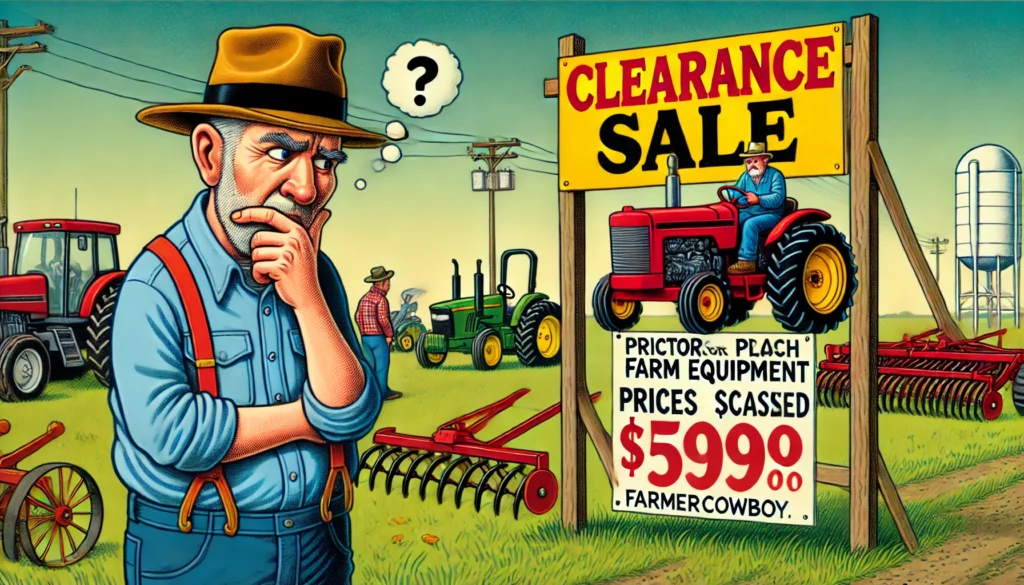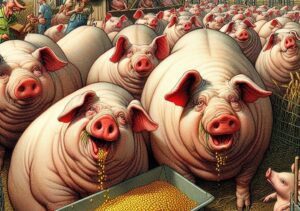
FarmerCowboy.com A humorous and vivid illustration of a farmer standing in front of a clearance sale sign for farm equipment. The farmer looks skeptical as prices ar3.webp.webp
Why Lower Farm Equipment Prices Are Bad News: The Bargain That’s Breaking the Bank!
“Think cheaper tractors are a blessing? Think again—here’s why your wallet might suffer more than you think!”
Pennypinch, Iowa — Farmers across America are facing an unexpected dilemma: lower farm equipment prices. At first glance, these slashed prices seem like a welcome relief for cash-strapped farmers. But in the topsy-turvy world of agriculture, where nothing is as it seems, this “blessing” may be more of a curse.
In a sector already reeling from falling incomes, rising costs, and the pressures of climate change, the last thing farmers need is a further destabilization of the market. Lower equipment prices are not a sign of generosity from manufacturers but a clear indication that demand has plummeted. And that means fewer farms are surviving.
When you can buy a tractor for less than the price of a new pickup truck, it’s not because the manufacturers have suddenly decided to play Santa Claus. No, the truth is far bleaker: the market is shrinking faster than a puddle in a drought. Farmers who once prided themselves on owning top-of-the-line equipment are now left wondering if they’ll be able to afford to keep their operations running at all.
Cheap Plows, Expensive Problems: The Dark Side of Discounted Equipment
Lower prices on farm equipment might seem like a good thing—after all, who wouldn’t want to save money on a new combine or plow? But in reality, these bargain-bin prices are a symptom of a much larger problem.
Take Farmer Joe from Pennypinch, Iowa, who recently scored a brand-new tractor for half the price he’d been expecting to pay. At first, Joe was thrilled. “I couldn’t believe my luck,” he said. “I’ve been eyeing that tractor for years, and when the price dropped, I jumped on it.”
But Joe’s excitement quickly turned to concern when he realized why the price had dropped. “It’s because no one else is buying them,” he explained. “The market’s drying up, and that’s bad news for all of us.”
In the world of farming, lower prices on equipment are not a sign of a healthy market. Instead, they’re a flashing neon sign that the industry is in trouble. Fewer farms are staying afloat, and that means fewer people are buying the equipment they need to keep their operations running. And when demand drops, so do prices.

The Reverse Auction: When Going Down Means Going Broke
At the Pennypinch County Farm Auction, where reverse auctioneers rule the roost, the atmosphere is tense. Farmers gather around, watching as the auctioneer starts the bidding at $100, then drops it to $90, then $80, as the price plummets with each call.
“It’s like watching a slow-motion train wreck,” said Sally “Bargain Hunter” McCoy, a regular at the auctions. “Sure, I got a new plow for half what I expected, but that just means no one else was bidding. What happens when no one’s bidding on our crops?”
Reverse auctions, where the price drops instead of rising, have become a popular way to offload farm equipment that no one else wants. But while these auctions might seem like a good deal for buyers, they’re a disaster for the industry as a whole. When prices drop this low, it’s a sign that the market is collapsing.

Public Opinion: The High Cost of Low Prices
Public sentiment on lower farm equipment prices is divided. On one hand, many farmers are thrilled to finally afford the equipment they need without breaking the bank. On the other hand, there’s a growing sense of unease about what these low prices mean for the future of the industry.
“I guess it’s nice that I can afford a new tractor,” said Farmer Bill “Discount Dan” Henderson. “But at the same time, it makes me wonder what’s happening to everyone else. If the prices are this low, it means people aren’t buying. And if people aren’t buying, it means farms are going under.”
Economists like Dr. Penny Pincher have been sounding the alarm for years. “Lower prices on farm equipment might help farmers in the short term, but the overall impact is negative,” she explained. “When the market is saturated with discounted equipment, it’s a sign that the industry isn’t growing—it’s contracting.”
Clearance Catastrophe: When Farm Equipment Goes on Sale, Everyone Loses
Imagine walking into a store and seeing everything marked down to clearance prices. Sounds great, right? But what if that store was your local farm equipment dealer? What if those clearance prices weren’t just a seasonal sale but a reflection of a shrinking market?
This is the reality that many farmers are facing. Clearance sales on farm equipment aren’t just a good deal—they’re a sign that the industry is in free fall. And when farm equipment goes on clearance, it’s not just the price tags that are slashed—so are the futures of small farmers.
“Every time I see a clearance sale on farm equipment, I get a sinking feeling in my gut,” said Farmer Jane “Lowball” Johnson. “It’s like watching the industry crumble before my eyes. Sure, I’m getting a good deal, but at what cost?”
Anecdotes from the Field: Stories of Struggle and Survival
Farmer Joe isn’t the only one feeling the pinch. Across the country, farmers are sharing stories of struggle and survival as they navigate the challenges of the agricultural downturn.
Take Farmer Bob “Pennywise” Thompson, who managed to score a brand-new hay baler for less than the price of a used one. “At first, I was thrilled,” he said. “But then I started thinking—why was no one else bidding? It’s because no one can afford it anymore. We’re all struggling, and these low prices are just a reflection of that.”
Another farmer, Betty “Bargain Hunter” Green, shared a similar tale. “I was eyeing this tractor, and I thought for sure someone would outbid me. But the price just kept dropping, and before I knew it, I had it for $5,000 less than I was willing to pay. It was like Christmas in July!”
But for every story of a farmer scoring a deal, there’s another story of a farmer who couldn’t make ends meet. The reality is that lower prices on farm equipment are a double-edged sword—while they might help some farmers in the short term, they’re a symptom of a much larger problem.
Expert Insights: The Economics of Cheap Equipment
Agricultural economists have been keeping a close eye on the situation, and many are sounding the alarm. “Lower equipment prices are a symptom of a larger problem,” said Dr. Clara “Crops” Greenfield, a leading agricultural economist. “The agricultural industry is facing unprecedented challenges, and these price drops are just the tip of the iceberg. We need to address the root causes—declining farm incomes, rising costs, and the loss of small farms—if we want to see real change.”
Dr. Greenfield isn’t the only one raising concerns. Other experts have pointed out that lower prices on farm equipment could lead to increased pressure on manufacturers to lower their prices, which could, in turn, affect the quality of the equipment being produced.
“It’s a delicate balance,” said Dr. Penny Pincher. “But if done right, reverse auctions could be a game-changer for the industry. However, we need to be careful that we’re not sacrificing quality for the sake of saving a few bucks.”
The Future of Farming: A Hypothetical Look at 2050
Imagine a future where farm equipment prices are so low that even the smallest farmers can afford the latest technology. Sounds great, right? But in this hypothetical world, the number of farms has dwindled to a fraction of what it once was, and the few remaining farmers are left to pick over the scraps of a once-thriving industry.
In this future, the auctioneer’s call of “Going once, going twice—sold!” is met not with cheers, but with sighs of relief from the few who managed to hold on.
But for those who couldn’t keep up, the future is bleak. Small farms have disappeared, replaced by sprawling mega-farms that dominate the landscape. The equipment may be cheap, but the cost to the industry has been immense.
The Real Cost of Low Prices: A Call to Action
The agricultural industry is facing a crisis, and lower prices on farm equipment are just one symptom of a much larger problem. Farmers, policymakers, and industry leaders need to come together to address the root causes of the downturn and find ways to support small farms.
While reverse auctions and discounted equipment might offer some relief in the short term, they’re not a sustainable solution. The industry needs to focus on long-term strategies that will help farmers thrive, not just survive.
As Farmer Joe put it, “We need to stop thinking about short-term gains and start focusing on the long-term health of the industry. Because if we don’t, we’re all going to end up with a lot of cheap equipment and nowhere to use it.”
Step-by-Step Guides for Farmers & Cowboy Readers
- Step-by-step guide to surviving the downturn: Don’t be swayed by lower prices—focus on long-term sustainability.
- Pro tips: Invest in quality, not just quantity. Cheaper equipment might save you money now, but what about the long-term costs?
- Insider knowledge: Stay informed about market trends. The lower the prices go, the more cautious you should be.
- **Insider knowledge: Stay informed about market trends. The lower the prices go, the more cautious you should be.
- Best practices: Consider alternative revenue streams—diversification is key to surviving tough times.
- Resourceful content: Don’t just chase bargains—focus on what will keep your farm running for years to come.
Disclaimer:
This article is a satirical piece and should not be taken as professional financial advice. While reverse auctions and low equipment prices might sound appealing, it’s important to consider the long-term implications for your farm and the industry. No tractors were harmed in the making of this story, though several were sold at rock-bottom prices.
15 Humorous Observations on “Lower Farm Equipment Prices Are Bad News”
- Discount Despair: When your tractor’s on sale for half-off, it’s not a deal—it’s a distress signal from the farm economy.
- Cheap Plows, Expensive Problems: A cheaper plow might look like a steal, but it’s really just a sign that everyone else is running for the hills.
- Bargain-Bin Baler: When your baler’s price is lower than a bale of hay, you know the market is in serious trouble.
- Sale of the Century: When farm equipment prices drop faster than a lead balloon, it’s time to start worrying, not celebrating.
- Clearance Catastrophe: A clearance sale on combines isn’t just a good deal—it’s a warning that the ag sector is in free fall.
- Discount Dilemma: Sure, you got that tractor for half-off, but what happens when the other half of the industry disappears?
- Cheap and Cheerless: Low prices on farm equipment might make you smile now, but the long-term outlook is anything but cheerful.
- Pennies for Plows: When you’re paying pennies for plows, the real cost might be in what’s happening to the rest of the industry.
- Clearance Sale Carnage: When farm equipment goes on clearance, it’s not just the price tags that are slashed—so are the futures of small farmers.
- Rolling in Discounts: Lower prices on tractors might feel like a win, but in reality, it’s a sign that no one’s really winning.
- Cheaper, But Costlier: That discount baler might save you money now, but what about the long-term costs to the ag economy?
- Tractor Trouble: A tractor at half price isn’t a victory—it’s a symptom of an industry in distress.
- Budget Buster: Low prices on farm equipment might help your budget, but they’re also a sign that the industry’s bottom line is busted.
- Cut-Price Catastrophe: When farm equipment prices hit rock bottom, it’s not just the equipment that’s breaking—it’s the whole system.
- Dollar-Store Disaster: When farm equipment feels like it belongs in the dollar store, it’s time to start worrying about the future of farming.
Originally Published at FarmerCowboy.com
2024-08-19 09:38:20
Karl Hoffman is a distinguished agriculturalist with over four decades of experience in sustainable farming practices. He holds a Ph.D. in Agronomy from Cornell University and has made significant contributions as a professor at Iowa State University. Hoffman’s groundbreaking research on integrated pest management and soil health has revolutionized modern agriculture. As a respected farm journalist, his column “Field Notes with Karl Hoffman” and his blog “The Modern Farmer” provide insightful, practical advice to a global audience. Hoffman’s work with the USDA and the United Nations FAO has enhanced food security worldwide. His awards include the USDA’s Distinguished Service Award and the World Food Prize, reflecting his profound impact on agriculture and sustainability.





The internet opens up new possibilities for learning, helping us grow beyond traditional boundaries. ??
Negativity’s like a flat tire—annoying but fixable. Farm.FM is the musical repair kit we all need.
My kids love dancing to Farm Radio while we make breakfast. It’s a family tradition now!